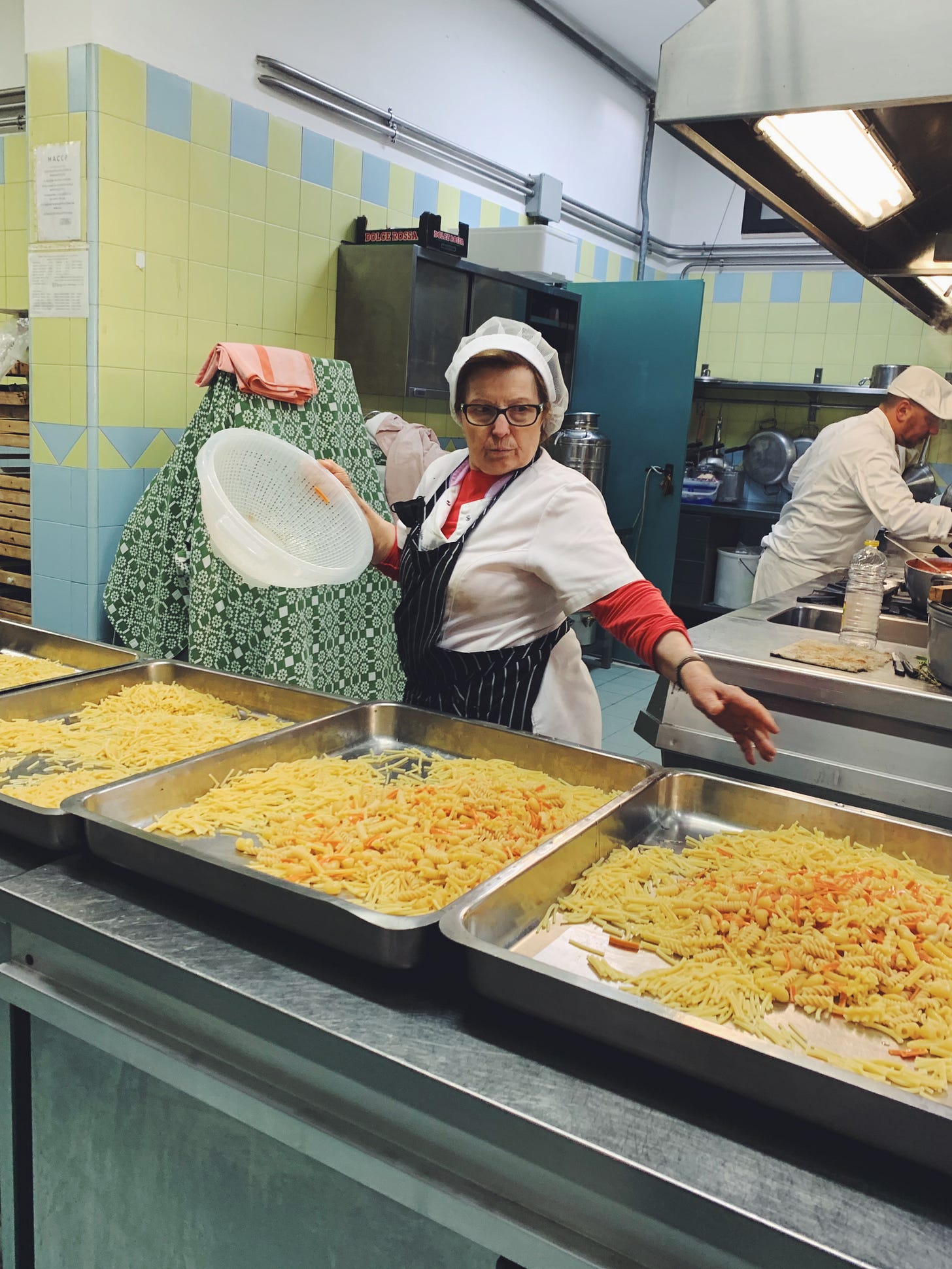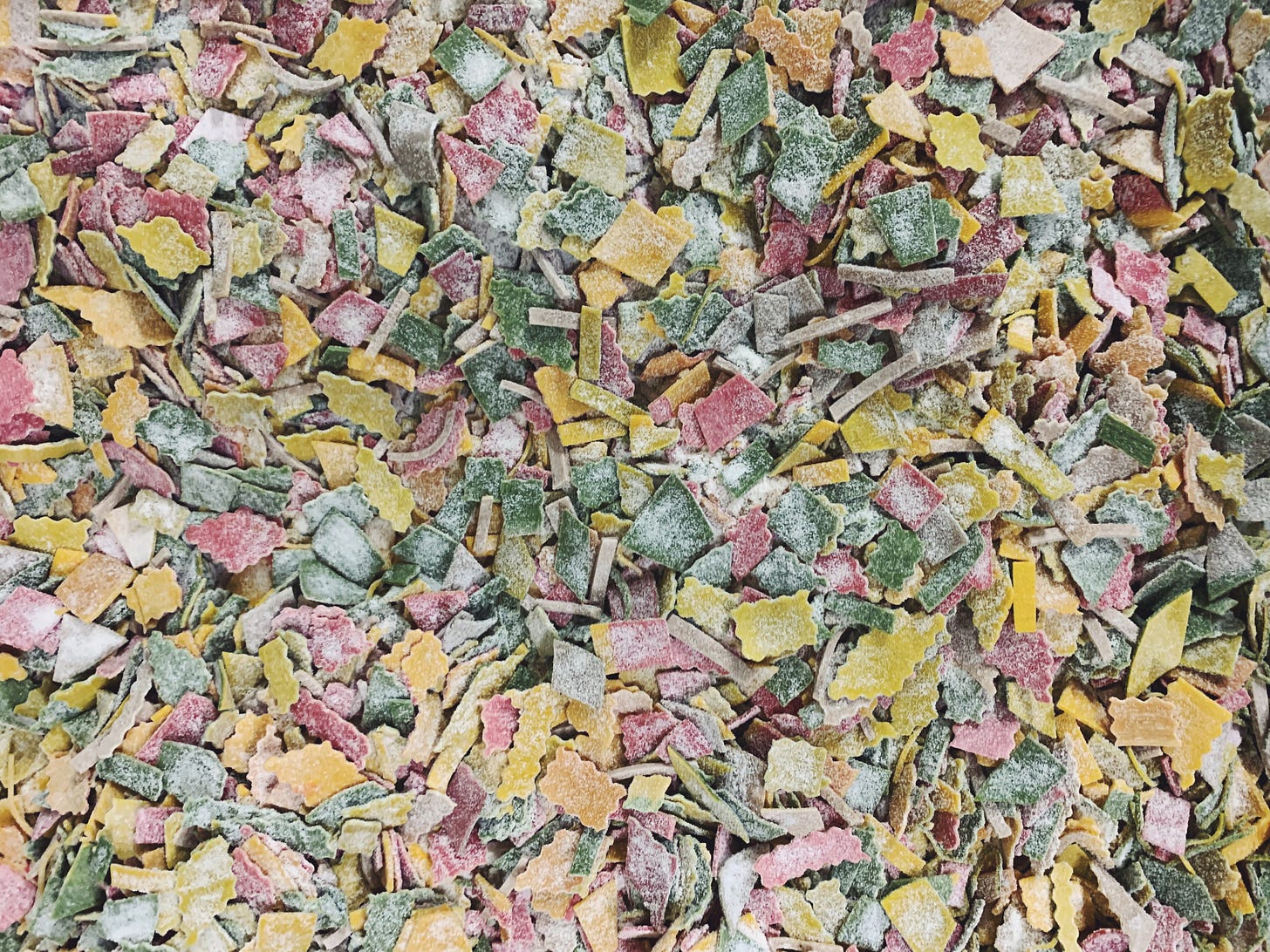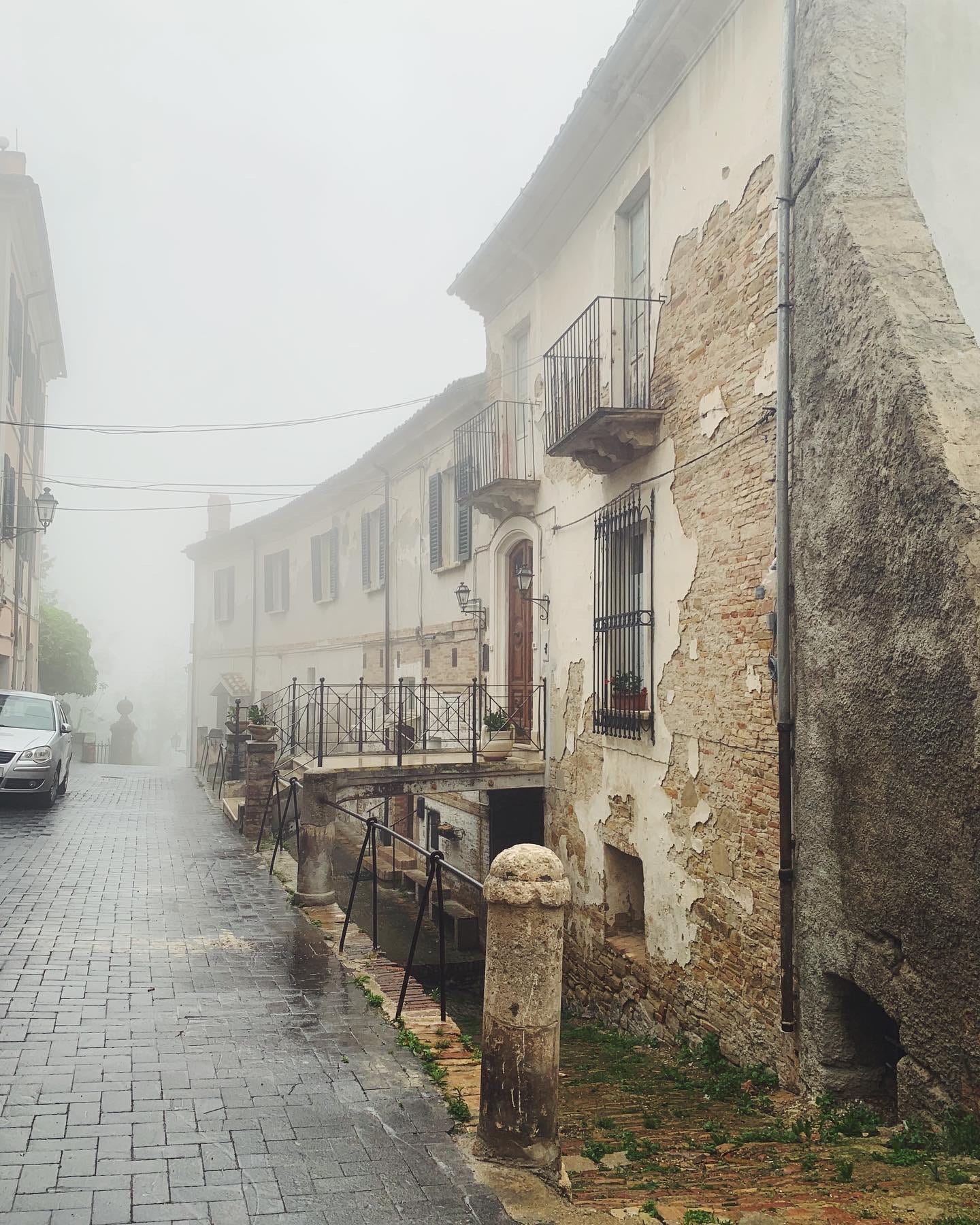
Happy Sunday and Happy Mother’s Day to all the mammas out there!
I was privileged to spend last Sunday with a mother and daughter here in Abruzzo learning the art of le virtù, an iconic “minestrone” originally from the city of Teramo that is prepared just once a year—the first of May. It calls for more than 40 ingredients and requires at least two days of labor to pull off. I put the word minestrone in quotes in the previous sentence because, frankly, the dish is much more than that (I say this as a devoted minestrone lover), and locals frown on equating the two. Le virtù (translation: the virtues) is a bowl of history, an expression of territory, of the green hills and rugged mountains that form the backdrop to this part of Italy; it’s a farewell to winter and a hail to spring; and, more recently, it’s become a traditional dish locally with which to celebrate Italy’s Labor Day, which falls on May 1.
My thanks to my friend Rolando (you remember Rolando, si?) who helped me wrangle an invitation to watch le virtù being made at Ristorante La Bilancia, outside of Loreto Aprutino and just down the winding hill road from my little house in Penne. The restaurant would be serving the soup (if it can even be called that!), as part of a five-course Primo Maggio menu, to some 250 people later that day. Rolando’s friend Ute Di Zio, daughter of proprietors Nicola Sergio Di Zio and Antonietta Marrone, assured me that 4 a.m. was not too early to show up, but I was reluctant to knock on the door at that hour, so I waited until 5. As Ute led me through the darkened dining room and into the quietly humming kitchen, I could see that I needn’t have worried; preparations were already well underway. A dense brew of minced aromatic vegetables, beans, and legumes—brown borlotti, red and yellow chickpeas, lentils, and gigantic white beans known as “fagioloni”—was resting in an enormous stainless-steel vat at one end of an enormous commercial cooking suite (basically a giant restaurant range).
I watched as Ute’s mother, Antonietta, stirred it with an oversized stainless-steel spatula and Ute tipped in a great aluminum panful of “tondini del Tavo,” small, round, locally grown beans with the creamy-coarse texture of cannellini. All of the dried legumes and beans, I was told, had been soaked overnight and then cooked separately, starting at about 3 a.m., before being united in the vat. Together, they comprised one component of le virtù. There was much more to come—veal stock; at least a dozen types of pasta; a parade of fresh spring greens; and a soffritto made from various pig parts, aromatic vegetables, and wild herbs.
The origins of le virtù are murky. It’s possible that the dish dates to Roman times, part of a tradition of gathering and cooking legumes in May, according to my friend and fellow Abruzzese-American, Francis Cratil. Francis, together with his wife, Cathy, owns Le Virtù, a restaurant in Philadelphia that specializes in Abruzzese cuisine and is named for the iconic dish (like La Bilancia, Le Virtù serves it once a year, on May 1). The name of the dish is said to refer to the seven heavenly virtues of Christian tradition that stand in opposition to the seven deadly sins. But local lore holds that it comes from the first time it was ever prepared, by seven virgins from Teramo, to serve to a visiting prince. Each virtuous cook contributed seven components to the pot (seven types of legumes, seven types of pasta, seven types of herbs, and so on), yielding a rich, savory concoction of some 49 ingredients.
The more prosaic (and realistic) explanation, is that the soup evolved as a vehicle for Teramana housewives to clear out their larders and use up whatever remained from the previous year’s harvest. Combining last season’s dried beans, cured meats, and bones with spring’s new tender offerings was a way to, hopefully, conjure a bountiful harvest in the months ahead. The care and intention with which each ingredient is cooked on its own before being combined with the others, and the close attention paid to the balance of flavors, are what distinguish this from an ordinary minestrone or “clean out the pantry” soup.
By the 18th century, le virtù had become a celebratory—and celebrated—dish of la cucina Teramana, and especially a celebration of the women who cooked it. Every cook who makes it has her own version. But because it’s such a labor-intensive dish, impossible to make in small quantities due to the sheer number of ingredients required, not many people make it at home anymore. For those who do, there is an unwritten rule that you must share some of your virtù with your neighbor, and vice versa. While this doesn’t get rid of the problem of excess soup, it is considered an essential gesture of friendship and good will.
La Bilancia, which opened as a restaurant in 1974 (and a hotel a decade later), serves traditional country food—spaghetti alla chitarra, gnocchi, roast and grilled meat, and the like. The restaurant has been making serving le virtù for at least 20 years, possibly closer to 30, Ute told me, and the event always sells out weeks in advance. (Side note: La Bilancia is located just over the border from Teramo province in the province of Pescara. Normally, this would disqualify it from being able to serve le virtù with any credibility. But because Loreto Aprutino was part of Teramo province until 1927, the restaurant can claim authenticity. While this may sound silly to us outsiders, the Abruzzesi are keenly aware of the differences in the cuisines of the four provinces that comprise the region and take great pride in them—so much so that the La Bilancia makes a point of noting its ties to Teramo in the printed menu that accompanies the May meal).
Back in the kitchen, Ute and Antonietta continued working quietly and efficiently together. In a vestibule off the main kitchen, stood a giant stockpot of veal broth simmering on a portable burner, steam rising up from beneath its lid in the early morning chill. From time to time, Antonietta lifted the lid to toss in more ingredients—several large stalks of celery, an onion—and give the broth a stir. Over the course of about 30 minutes, Ute went back and forth from the main kitchen to a cooler around the corner, returning each time laden with enormous stainless steel trays of vegetables that had been cooked the day before, either boiled, blanched, steamed, or sautéed: artichokes, asparagus, broccoli, cauliflower, chard, fava beans, peas, agretti (monk’s beard), string beans, romano (flat) beans, spinach, zucchini, and something called “misticanza,” which is a mix of wild greens that grow in the nearby countryside. Each vegetable occupied its own tray; each had been reduced to uniform bite-sized pieces, the greens chopped. When the time was right, Ute would add them, one by one, to the legumes. Eventually, the vat would no longer hold all the ingredients, and so began the process of dividing them between the vat and three large pots, so that there were four massive vessels in all.
More cooks started showing up at 7 a.m. to work on the rest of the meal (spaghetti alla chitarra, veal roast, mutton stew, and sponge cakes with fruit and whipped cream). But before those tasks came the parboiling of the pasta for le virtù, which required nearly all hands on deck. It sounds like an easy task, but we’re talking about 20 kg (44 lb) of fresh pasta alone.
There were four types of colored fresh pasta that had been made the previous day (saffron, beet, spinach, and whole-wheat), each type cut by hand into maltagliati. Among the dried pasta, I counted 10 shapes: anellini, bucatini, candele, cavatappi, cavatelli, cresti di gallo, fusilli, lumachel, spaghetti, and ziti. It took nearly an hour of parboiling, rinsing, and finally mixing all the pasta together in seven large metal trays (and dousing it with generous amounts of sunflower oil to prevent it from sticking) to get it done.
Throughout the morning I had been eyeing a large frying pan that looked to be filled with minced vegetables. This, Ute said, was the soffritto, the most important component of le virtù. A soffritto is the foundation of countless Italian sauces, soups, stews, roasts, and braises. Typically, it’s a fine mince of carrots, celery, and onions, sometimes garlic, plus aromatics such as parsley or rosemary, and often a piece of pork—typically guanciale or pancetta, either in one piece or chopped. The soffritto for le virtù, not surprisingly, is a more complicated affair, with finely diced cotenna (pork rind that has been boiled to render away excess fat), prosciutto, and other pig parts, cut into minute dice and sautéed slowly in olive oil with finely chopped vegetables and lots of foraged, feathery wild fennel to yield a meltingly tender soffritto. “This more than anything is what makes the flavor of le virtù,” Ute said.
At the right moment, all the components would be brought together: the legumes and vegetables, the many types of blanched greens, the pasta, the veal stock, and the soffritto. Combining everything too early, or overcooking the virtù, would ruin the careful balance of flavors and textures.
I had been invited to stay for lunch, but between travel (I had just arrived from the U.S. the day before), jet lag, and the early wakeup call, I had gotten about 6 hours sleep in the last 56. (I also didn’t want to be a solo diner among a sea of families who probably all knew one another. And, although I’m triple-vaccinated, I’m still taking precautions to minimize possible exposure to Covid.) Instead, Ute and Antonietta assembled a container of le virtù for me to take home. Later in the afternoon (after a nap) I heated it gently on the stovetop. What struck me after my first spoonful was how fresh it tasted; rich and substantial, but not at all stodgy, in spite of everything I knew it to contain. With each bite, I could detect distinct flavors, a hit of wild fennel, a whiff of porkiness, the rich undertone of veal broth, the earthiness of borlotti and tondini del Tavo, a tender bite of asparagus or pasta, a creamy wedge of artichoke. Even the leftovers I reheated that evening for dinner were delicious.
I know that some of you (though maybe not all!) would love a recipe, and I would love to share one with you, but I don’t have it. At least not yet. Is there a way to faithfully recreate this masterpiece of Teramana country cooking at home if you don’t have access to ingredients like cotenna and tondini del Tavo and wild fennel picked from the nearby hills? I don’t know, but I’m going to try, though it may take me until next May. In the meantime, let me point you to this “cheater’s” version that I found on my friend Frank Fariello’s blog, Memorie di Angelina. Frank writes about and posts traditional recipes from all over Italy—good recipes that work. I have no doubt his adaptation is faithful in spirit to the original.
On to Southern Italy
On Tuesday I’ll be driving down to Capaccio, near Paestum, for Food Writers in Cilento. This workshop was supposed to happen in 2019 (thanks, Covid) and I’m thrilled that it is finally upon us. If you’d like to follow along, I’ll be posting photos and updates on Instagram. (It’s also where I’ve been posting daily pics etc. from Abruzzo.)
PICTURE ITALY: Penne, Abruzzo, May 2022
As always, thank you for reading, subscribing, and sharing.
Alla prossima,
Domenica












Oh my gosh, Domenica, what an amazing experience you just toured us through! I was so taken with the separate cooking of each ingredient. Thank you for this beautifully written (and illustrated) piece! Happy Mother’s Day! 🌺
I've been smiling since I started reading!
I love it. I remember the beautiful statue and view from the top of the hill at Villa Durazzo.
The soup sounds amazing. How lucky for you to see it made by so many hands. Enjoy your
time to write! Looking forwarrd to my next Sunday smile! Happy Mother's Day! Thanks.